Spokes: |
|
Rim: |
|
Tires: |
|
Tubes: |
|
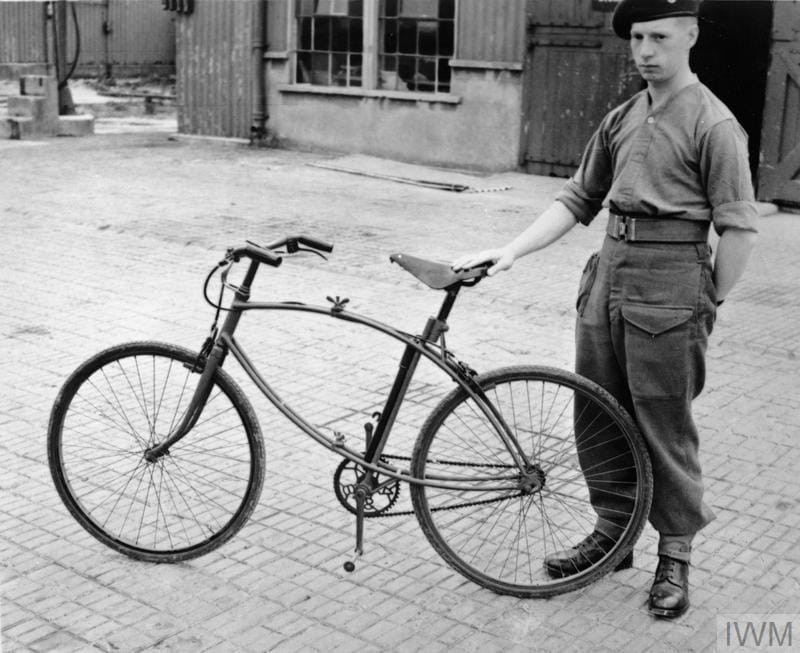
Spokes: |
|
Rim: |
|
Tires: |
|
Tubes: |
|
Handlebar: |
|
Headstock: |
|
Lamp Attachment: |
|
Grips: |
|
Everest Carrier: |
|
Inflator (pump): |
|
Lamp, Bicycle, Front, Electric: |
|
Rifle holders: |
|
Saddle bag: |
|
Tools: |
|
Valise: |
|
I acquired my BSA Bicycle, Folding, Airborne in December 2016 from a lad from Ottawa, Canada. The bicycle was in a derelict state BUT, happily, all parts were there! Sadly, the saddle (seat) was irreparably damaged. The complete restoration took three weeks and was done over the Holidays 2016.
First, it must be said that the restoration was a work of love even if it was my first time at restoring a vintage military vehicle! Space to work and to paint the Welbike was my first concern. Fortunately, Reg Hodgson, well-known vehicle restorer and longstanding member and Director Emeritus of the Military Vehicle Preservation Association (MVPA), kindly allowed me access to his motor pool and provided much helpful advice.
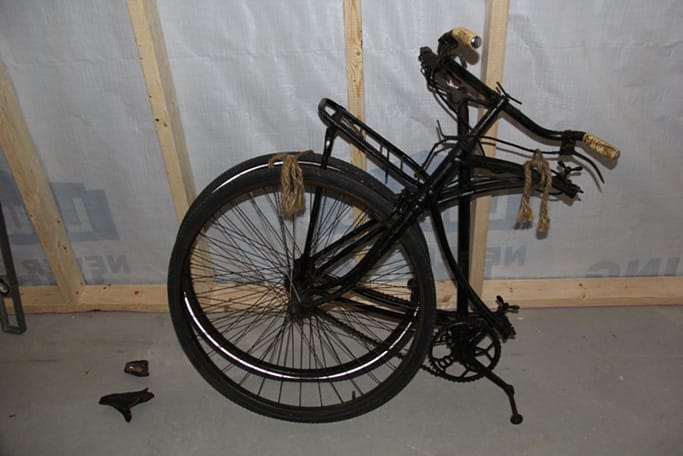
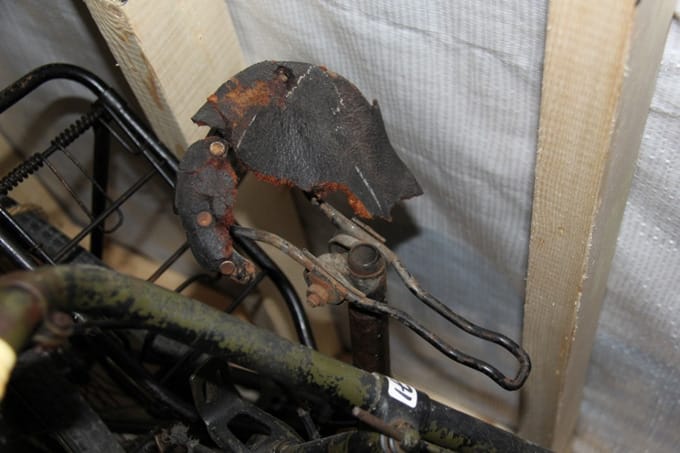
After inspection, I realised that the bicycle was in excellent condition and only required a good tune-up, a cosmetic restoration, new tires, a new saddle, new handlebars grips,
new transfers, and tools. The bicycle was completely dismantled including wheels, parts cleaned, and those with paint sandblasted and repainted.
While the frame was mainly painted in black, there were some parts on the bicycle that had green paint. It should be noted that black was the colour of the primer during the Second World War. Finding the right paint colour was a good challenge. The green was similar to Khaki Green G3 (KG3).
The basis for the camouflage pattern painting of military equipment was contained within Military Training Pamphlet (MTP) № 46, Part 4A: Painting of Mechanical Transport. This pamphlet, issued on 27 November 1941 contained guidance notes on the problems and basic principles of camouflage pattern painting of vehicles and was issued army wide. Vehicles were to be painted a basic camouflage colour, either Khaki Green G3 (KG3) or Standard Camouflage Colour (SCC) № 2 Brown. KG3, however, was rapidly replaced by SCC № 2 as stocks of Chromium Oxide required to make the Khaki Green paint became scarce. Equipment supplied from the United States were in US Olive Drab № 9. To produce uniformity, and to avoid repainting of US supplied vehicles, a British version of Olive Drab, SCC № 15, was introduced in the spring of 1944 as the basic colour, replacing SCC № 2. The SCC № 15 is slightly different than OD № 9. Initially, it was only to be used when repainting became necessary. Now the issue was to find the paint! After some research, I found that Krylon Camouflage Spray Paint, Ultra Flat, Olive was very close to the Olive Drab SCC № 15.
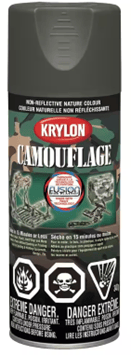
New transfers were needed. I found them from Stuart Bray Motorcycles Limited, in UK. Sadly, Stuart closed his business after 30 years due retirement.
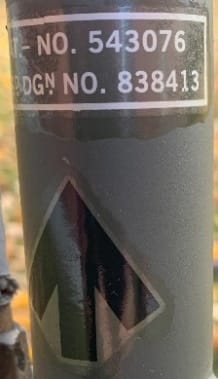

Tires were present with one being a “WAR GRADE”. Obviously, new tires were necessary to replace these old ones. I found on eBay UK a pair of 26 x1 3/8” (37-590) vintage of British Roadster black tires that a similar threat than the “WAR GRADE” ones. New
New grips were required. I found them from Stuart Bray Motorcycles Limited. Enthusiastic restorers sometimes offer reproductions.
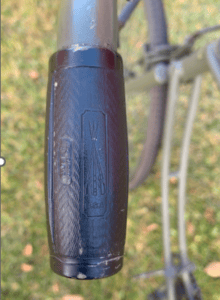
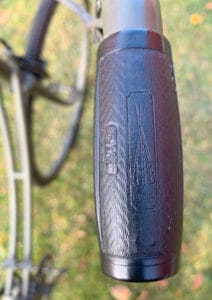
Only the frame from the saddle was present on the bicycle. Original BSA № 40 are barely unobtainable and if one is found, first the leather will be very brittle after so many years and secondly the price will be ridiculously exorbitant. From time to time, someone will made reproductions. So, since I wanted to ride the bicycle and not having a second mortgage on my house to buy an original one, I decided to look for a similar but modern pattern. I discovered that the during the war that bicycles were also equipped with Brooks saddle. I realized that the modern “Brook № 17” was a quasi-perfect match except for the missing oval stamped BSA trademark logo on the side and rear metal brand name. I found the Brook № 17 saddle at Mountain Equipment Company (MEC). It was the best solution to ride the bicycle.
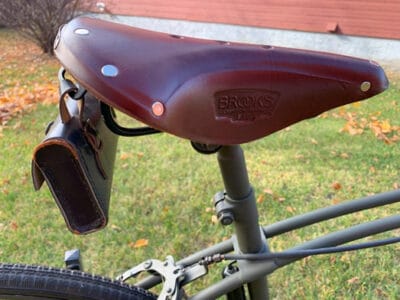
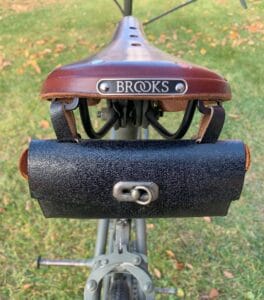
Like for the saddle, BSA inflator are barely unobtainable. I found on eBay a contemporary inflator; the “Featherweight” made by Bluemel’s. The saddle bag and tools were found on eBay.
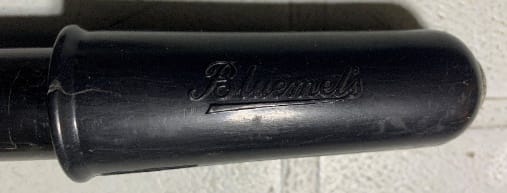


BSA Bicycle, Folding, Airborne Pattern Serial R36033 now!
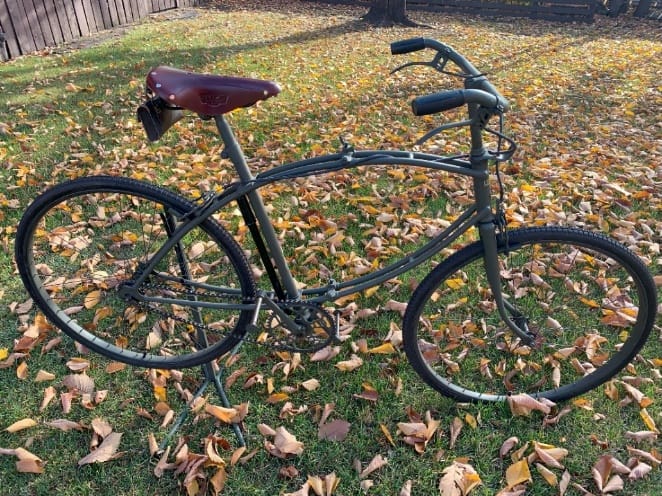

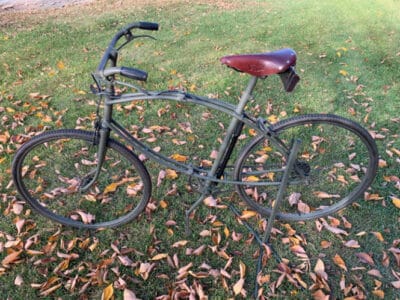
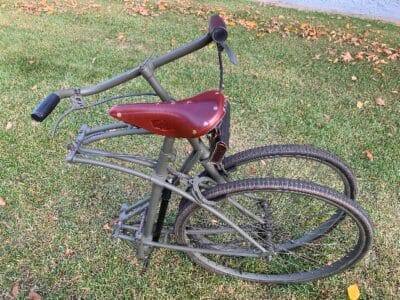
There will be more to see from our Quartermaster so…come to see us either at shows or our “micro” Museum! The VPA’s “micro” museum is located at SEBARMS Guns, Gear and Collectibles, 11569 – 149 Street, Edmonton, Alberta, T5M 1W9. The museum hours of operation are:
Until next time,
The Quartermaster
Air Ministry, Air Publication 2453A, Volume 1, Part 4, Section 2, Chapter 1, Equipment attached to the parachutist, Airborne Bicycle, May 1946
Canadian Army, War Establishment (WE) Cdn III/127/2 – A Canadian Parachute Battalion, Approved under COS 139, Effective Date 19th May 1944
Gordon, David B., Equipment of the WWII Tommy, Revised and Expended Edition, Pictorial Histories Publishing Co., Missoula, Montana, 2010, 658 pages, ISBN-13: 978-1-57510-151-4
War Office, 26 G.S. Publication 919 – Airborne Operation Pamphlet № 1, General, May 1943
British Pathé, Factory Making Bikes And Mini Bikes (1943), www.youtube.com/watch?v=InudgELqCHg
CaptainStevens, BSA Airborne Bicycle, www.captainstevens.com/military/mv/bsa-airborne-bicycle/
The BSA & Military Bicycle Museum, 1942 WW2 BSA Airborne Bicycle, 1st Pattern: Early Twin Tube Model, www.bsamuseum.wordpress.com/1942-ww2-bsa-airborne-bicycle-early-twin-tube-model/
The BSA & Military Bicycle Museum, 1942-1945 WW2 BSA Airborne Bicycle, 2nd Pattern, www.bsamuseum.wordpress.com/1942-1945-bsa-airborne-bicycle-para-bike/
Visual Collector, British BSA Folding Bicycle, www.visualcollector.com/OBLI/BSABike.htm

After the summer break, the Quartermaster is back with a presentation/display on the
Second World War BSA folding bicycle for the British Airborne Forces. Valor Park
Association (VPA) has been invited by Bike Edmonton to do a presentation on this
iconic war bicycle owned by Claude VILLENEUVE.
Bike Edmonton was established in 1980 as the Edmonton Bicycle Commuters Society. Bike Edmonton promotes the bicycle as a healthy, economical, and ecologically thorough mode of transportation by selling refurbished bikes, teaching, and helping fixing bikes, teaching how to ride, hosting events, and promoting accessible cycling for everyone in Edmonton. Thank you, Edmonton Bicycle, for hosting us!
The use of the bicycle by armies goes back well into the beginning of the 20th century.
During the First World War, the Canadian Expeditionary Force (CEF) had a Canadian Corps Cyclist Battalion made of three companies. The battalion saw active service in Belgium and France and was disbanded at the end of the war. The British Army had cyclist companies in its divisions, and later two whole divisions became cyclists: 1st and 2nd Cyclist Divisions. While the bicycle was extensively used during the Second World War, there was no bicycle unit as such in the Canadian Army as bicycles were superseded by motorized transport in modern armies. Switzerland was the last country to disband its bicycle unit, the Swiss Army’s Bicycle Regiment, in 2001. However, since the Russian invasion of Ukraine, Ukrainian soldiers have been using e-bikes armed with missiles to take out Russian tanks.
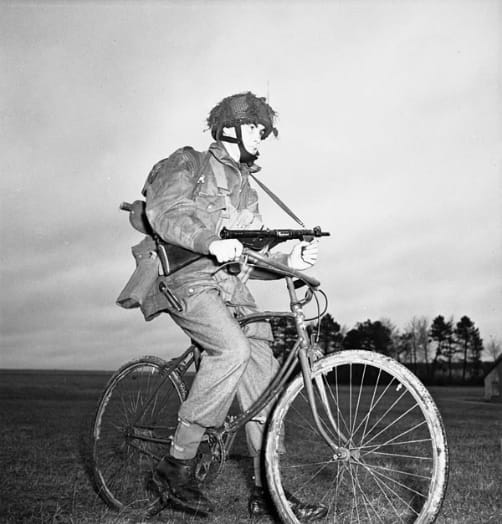
In 1941 bicycle manufacturer BSA Cycles Ltd., a subsidiary of Birmingham Small Arms (BSA), was asked by the War Office (WO) to design a folding bicycle for the newly created British Airborne Forces. Production started mid-1942 and probably ended by 1944. No war production records have been unearthed to date. Out of the 128,000 military bicycles manufactured by BSA Cycles Ltd during the Second World War over 60,000 folding bicycles were produced. The folding bicycle was used not only by airborne troops but also by the Royal Marine Commando and some infantry units during Operation OVERLORD (the Invasion). The life required was only 50 miles but in face some achieved many thousands of miles in private hands after the war. Around the end of the Second World War surplus bicycles were available for sale. In Canada, they were sold surplus by the Hudson’s Bay Company and by Capital Iron (surplus store) for about $9.95.

At its peak during the Second World War, BSA operated 67 factories producing weapons, bicycles, and motorcycles. BSA was founded in Birmingham in 1861 to provide weapons for the Crimean War. The company started diversifying its production in 1880s and created a new group to manufacture bicycles: The BSA Cycles Limited. The group will expend to manufacture motorcycles. In 1957 the bicycles division was sold to Raleigh Bicycle Company based in Nottingham, England.
Two patterns were produced. The First Pattern (Early Twin Tube Model) had the seat post, of a smaller diameter, inserted into a tube welded to the rear of the main post. The inflator (pump) was in the front of the main post. In the second model, in order to simplify the design and streamline the manufacturing of the bicycle, the seat post was incorporated into the main post (the seat tube) adding to the robustness of the bicycle. The inflator was positioned at the rear of the main post (seat tube).
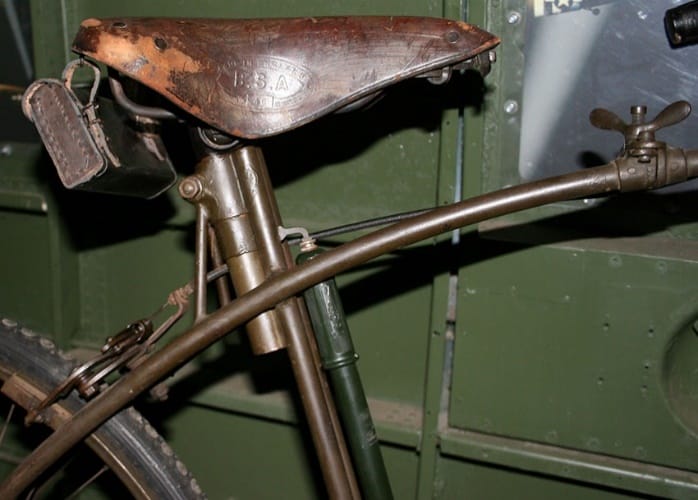
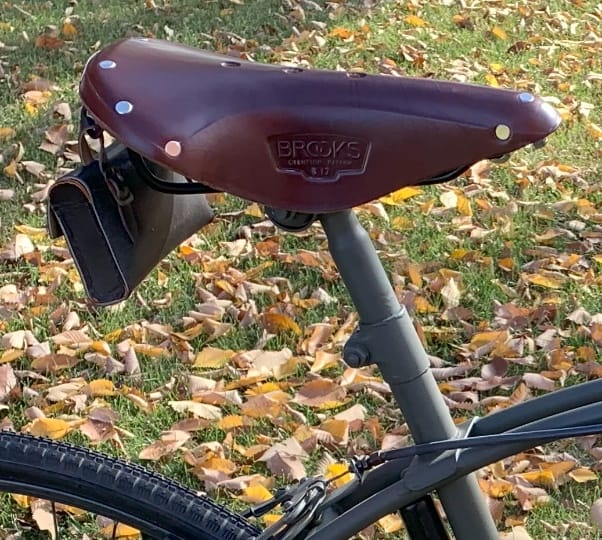
The thoughts behind the Bicycle, Folding, Airborne Pattern was that it would give foot soldiers some distinct advantages. The War Office (WO) felt that a paratrooper could cover up to 25 miles (40km) on foot in a 24-hour period, however, given a bicycle the same soldier could cover up to 75 miles (120km) in a 24-hour period (so three times the distance). Furthermore, a bicycle was relatively silent compared to a motorized scooter or vehicle. The issue really come down to the tires, once damaged it rendered the bicycle useless, which is why the BSA folding paratrooper bicycle was far better on paper than on the battlefield.
Chainrings on BSA Bicycle, Folding, Airborne Pattern have 46 teeth on the chainwheel and 18 teeth on the Mark X pattern freewheel rear sprocket which created a gear ratio of 2.555. With the bicycle having 26-inch diameter wheels (circumference of the tire being 81,68 inches) each pedal stroke moved the bicycle forward 208.69 inches (81,68 inches x 2.555). At 60 rotations per minute (RPM) this allowed for a speed close to 12 mph.
Speed in mph = (((((Tire Circumference in inches x Chainrings ratio) x RPM) x 60) / 12) / 5280)
So: ((((((26 x 3,14159) x (46 / 18) x 60) x 60) / 12) / 5280) = 11,86 mph
The War Establishment (WE) Cdn III/127/2 for A Canadian Parachute Battalion established at 16 the number of Bicycles, Folding, Airborne Pattern as follows:
There were three ways to bring the bike onto the battlefield.
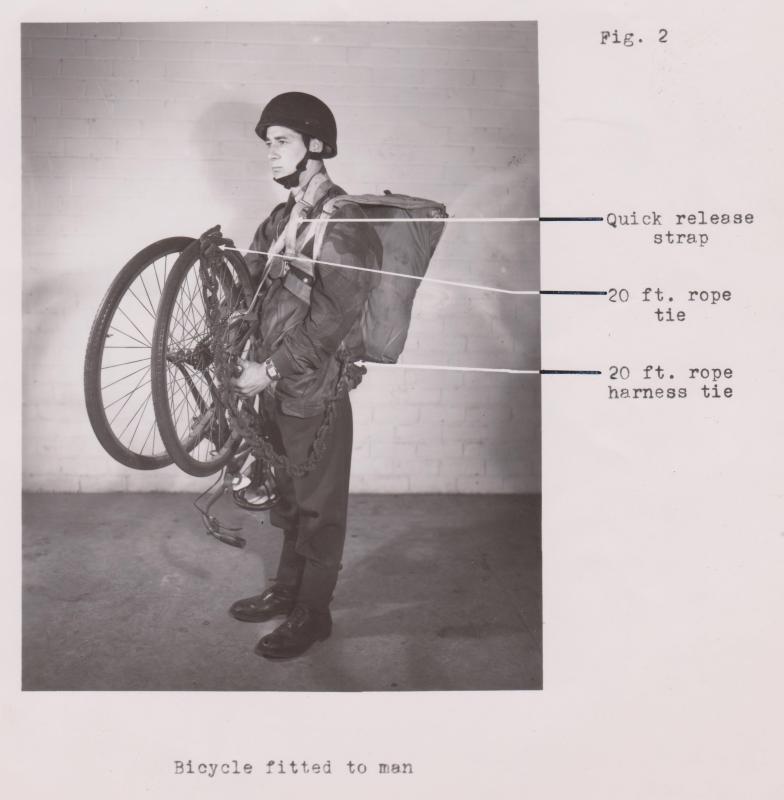
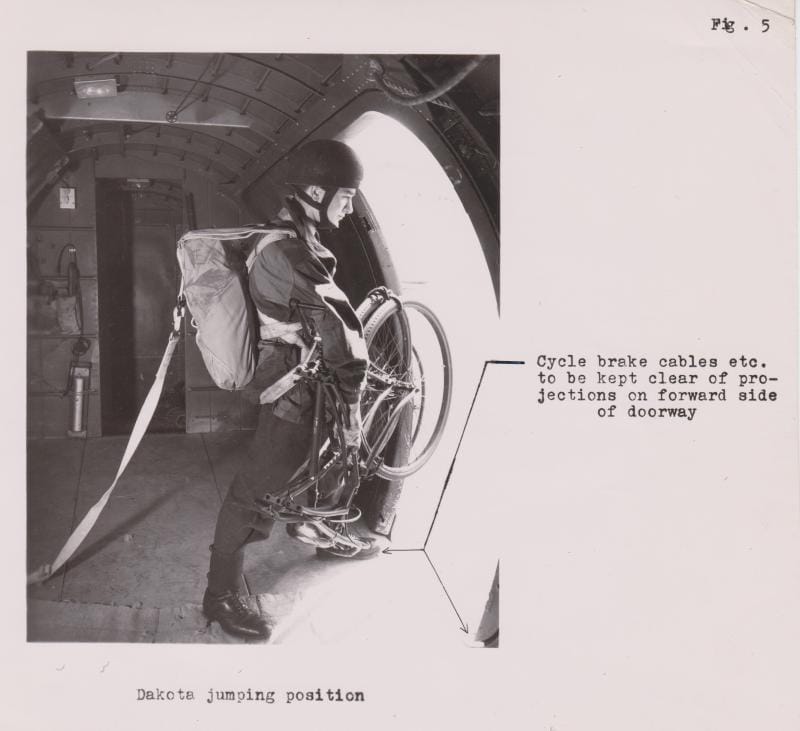
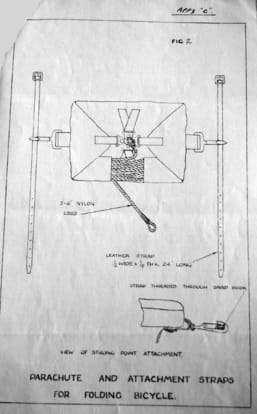
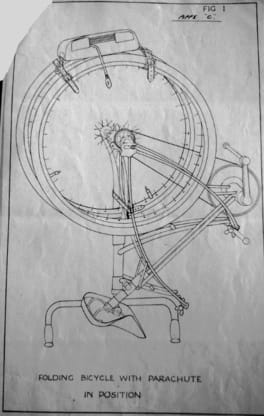
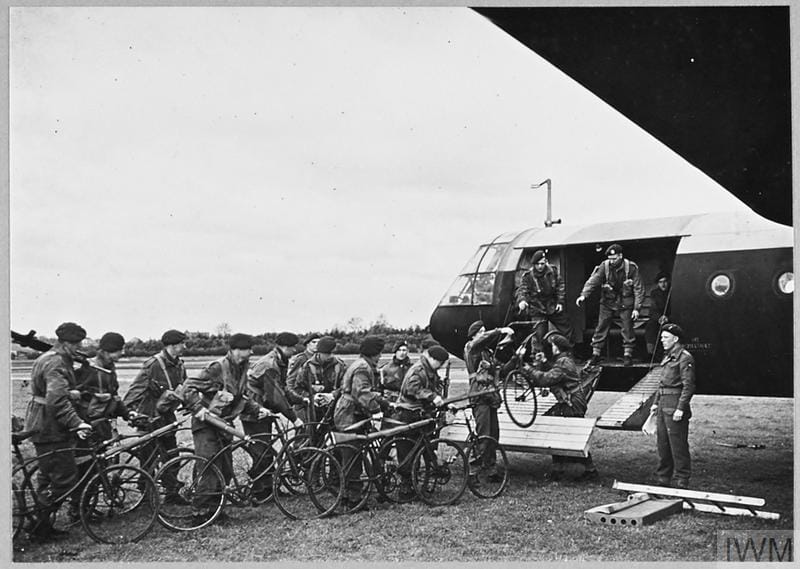
In practice, the parachute units dropped them by parachute in groups of three to be recovered by the troops after landing and for the glider units in gliders. The twin loop frame made of small diameter tubes provides low weight but maintains adequate rigidity. After loosening the two large thumbscrews, the front half of the frame can be folded sideways to overlap the rear half.
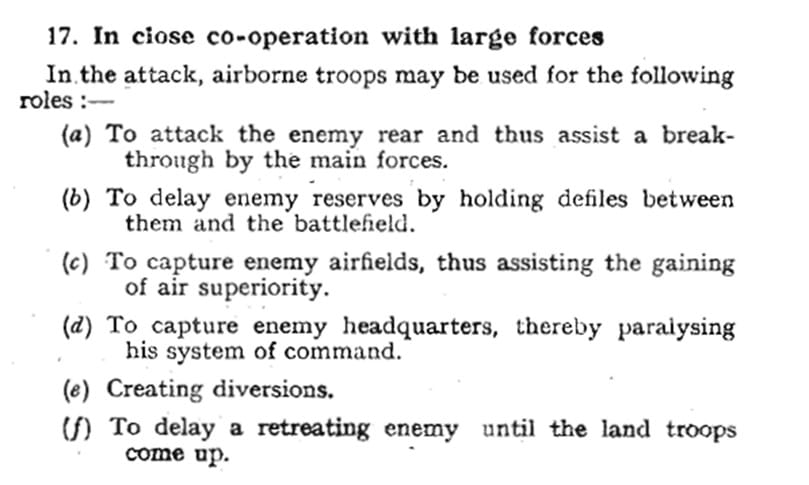
Was it much better on paper than on the battlefield? First, the bicycle had to survive the jump, either by jumping with it or dropped by parachute. Secondly, the tires once damaged will render the bike useless. Third, the very nature of airborne operations which required “pinpoint” and short-term military operations.
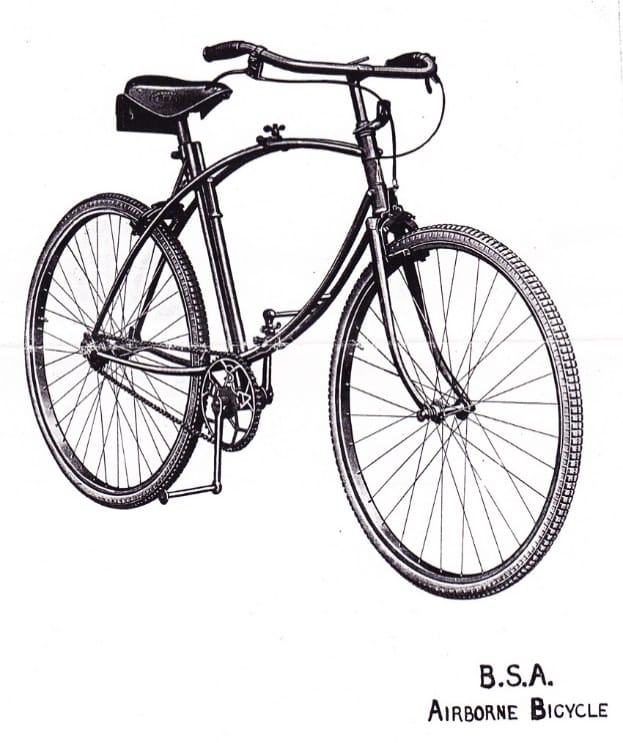

Production:
Serial number:
Spokes: |
|
Rim: |
|
Tires: |
|
Tubes: |
|
Handlebar: |
|
Headstock: |
|
Lamp Attachment: |
|
Grips: |
|
Everest Carrier: |
|
Inflator (pump): |
|
Lamp, Bicycle, Front, Electric: |
|
Rifle holders: |
|
Saddle bag: |
|
Tools: |
|
Valise: |
|
I acquired my BSA Bicycle, Folding, Airborne in December 2016 from a lad from Ottawa, Canada. The bicycle was in a derelict state BUT, happily, all parts were there! Sadly, the saddle (seat) was irreparably damaged. The complete restoration took three weeks and was done over the Holidays 2016.
First, it must be said that the restoration was a work of love even if it was my first time at restoring a vintage military vehicle! Space to work and to paint the Welbike was my first concern. Fortunately, Reg Hodgson, well-known vehicle restorer and longstanding member and Director Emeritus of the Military Vehicle Preservation Association (MVPA), kindly allowed me access to his motor pool and provided much helpful advice.


After inspection, I realised that the bicycle was in excellent condition and only required a good tune-up, a cosmetic restoration, new tires, a new saddle, new handlebars grips,
new transfers, and tools. The bicycle was completely dismantled including wheels, parts cleaned, and those with paint sandblasted and repainted.
While the frame was mainly painted in black, there were some parts on the bicycle that had green paint. It should be noted that black was the colour of the primer during the Second World War. Finding the right paint colour was a good challenge. The green was similar to Khaki Green G3 (KG3).
The basis for the camouflage pattern painting of military equipment was contained within Military Training Pamphlet (MTP) № 46, Part 4A: Painting of Mechanical Transport. This pamphlet, issued on 27 November 1941 contained guidance notes on the problems and basic principles of camouflage pattern painting of vehicles and was issued army wide. Vehicles were to be painted a basic camouflage colour, either Khaki Green G3 (KG3) or Standard Camouflage Colour (SCC) № 2 Brown. KG3, however, was rapidly replaced by SCC № 2 as stocks of Chromium Oxide required to make the Khaki Green paint became scarce. Equipment supplied from the United States were in US Olive Drab № 9. To produce uniformity, and to avoid repainting of US supplied vehicles, a British version of Olive Drab, SCC № 15, was introduced in the spring of 1944 as the basic colour, replacing SCC № 2. The SCC № 15 is slightly different than OD № 9. Initially, it was only to be used when repainting became necessary. Now the issue was to find the paint! After some research, I found that Krylon Camouflage Spray Paint, Ultra Flat, Olive was very close to the Olive Drab SCC № 15.

New transfers were needed. I found them from Stuart Bray Motorcycles Limited, in UK. Sadly, Stuart closed his business after 30 years due retirement.


Tires were present with one being a “WAR GRADE”. Obviously, new tires were necessary to replace these old ones. I found on eBay UK a pair of 26 x1 3/8” (37-590) vintage of British Roadster black tires that a similar threat than the “WAR GRADE” ones. New
New grips were required. I found them from Stuart Bray Motorcycles Limited. Enthusiastic restorers sometimes offer reproductions.


Only the frame from the saddle was present on the bicycle. Original BSA № 40 are barely unobtainable and if one is found, first the leather will be very brittle after so many years and secondly the price will be ridiculously exorbitant. From time to time, someone will made reproductions. So, since I wanted to ride the bicycle and not having a second mortgage on my house to buy an original one, I decided to look for a similar but modern pattern. I discovered that the during the war that bicycles were also equipped with Brooks saddle. I realized that the modern “Brook № 17” was a quasi-perfect match except for the missing oval stamped BSA trademark logo on the side and rear metal brand name. I found the Brook № 17 saddle at Mountain Equipment Company (MEC). It was the best solution to ride the bicycle.


Like for the saddle, BSA inflator are barely unobtainable. I found on eBay a contemporary inflator; the “Featherweight” made by Bluemel’s. The saddle bag and tools were found on eBay.



BSA Bicycle, Folding, Airborne Pattern Serial R36033 now!




There will be more to see from our Quartermaster so…come to see us either at shows or our “micro” Museum! The VPA’s “micro” museum is located at SEBARMS Guns, Gear and Collectibles, 11569 – 149 Street, Edmonton, Alberta, T5M 1W9. The museum hours of operation are:
Until next time,
The Quartermaster
Air Ministry, Air Publication 2453A, Volume 1, Part 4, Section 2, Chapter 1, Equipment attached to the parachutist, Airborne Bicycle, May 1946
Canadian Army, War Establishment (WE) Cdn III/127/2 – A Canadian Parachute Battalion, Approved under COS 139, Effective Date 19th May 1944
Gordon, David B., Equipment of the WWII Tommy, Revised and Expended Edition, Pictorial Histories Publishing Co., Missoula, Montana, 2010, 658 pages, ISBN-13: 978-1-57510-151-4
War Office, 26 G.S. Publication 919 – Airborne Operation Pamphlet № 1, General, May 1943
British Pathé, Factory Making Bikes And Mini Bikes (1943), www.youtube.com/watch?v=InudgELqCHg
CaptainStevens, BSA Airborne Bicycle, www.captainstevens.com/military/mv/bsa-airborne-bicycle/
The BSA & Military Bicycle Museum, 1942 WW2 BSA Airborne Bicycle, 1st Pattern: Early Twin Tube Model, www.bsamuseum.wordpress.com/1942-ww2-bsa-airborne-bicycle-early-twin-tube-model/
The BSA & Military Bicycle Museum, 1942-1945 WW2 BSA Airborne Bicycle, 2nd Pattern, www.bsamuseum.wordpress.com/1942-1945-bsa-airborne-bicycle-para-bike/
Visual Collector, British BSA Folding Bicycle, www.visualcollector.com/OBLI/BSABike.htm
Pedals: |
| ||||||||||||||||||||||||||||||||||||||||||||||||||||||||||||||||||||||||||||||||||||||||||||||||||||||||||||||||||||||||||||||||||||||||||||||||||||||||||||||||||||||||||||||||||||||||||||||||||||||||||
Chain: |
| ||||||||||||||||||||||||||||||||||||||||||||||||||||||||||||||||||||||||||||||||||||||||||||||||||||||||||||||||||||||||||||||||||||||||||||||||||||||||||||||||||||||||||||||||||||||||||||||||||||||||||
Chainwheel: |
| ||||||||||||||||||||||||||||||||||||||||||||||||||||||||||||||||||||||||||||||||||||||||||||||||||||||||||||||||||||||||||||||||||||||||||||||||||||||||||||||||||||||||||||||||||||||||||||||||||||||||||
Rear wheel sprocket: |
| ||||||||||||||||||||||||||||||||||||||||||||||||||||||||||||||||||||||||||||||||||||||||||||||||||||||||||||||||||||||||||||||||||||||||||||||||||||||||||||||||||||||||||||||||||||||||||||||||||||||||||
Gear ratio: |
| ||||||||||||||||||||||||||||||||||||||||||||||||||||||||||||||||||||||||||||||||||||||||||||||||||||||||||||||||||||||||||||||||||||||||||||||||||||||||||||||||||||||||||||||||||||||||||||||||||||||||||
Brakes: |
Wheel
Front set
Saddle areaAccessories
RESTORATION OF BSA BICYCLE, FOLDING, AIRBORNE PATTERN R36033I acquired my BSA Bicycle, Folding, Airborne in December 2016 from a lad from Ottawa, Canada. The bicycle was in a derelict state BUT, happily, all parts were there! Sadly, the saddle (seat) was irreparably damaged. The complete restoration took three weeks and was done over the Holidays 2016. State of the bicycleFirst, it must be said that the restoration was a work of love even if it was my first time at restoring a vintage military vehicle! Space to work and to paint the Welbike was my first concern. Fortunately, Reg Hodgson, well-known vehicle restorer and longstanding member and Director Emeritus of the Military Vehicle Preservation Association (MVPA), kindly allowed me access to his motor pool and provided much helpful advice.   After inspection, I realised that the bicycle was in excellent condition and only required a good tune-up, a cosmetic restoration, new tires, a new saddle, new handlebars grips, PaintWhile the frame was mainly painted in black, there were some parts on the bicycle that had green paint. It should be noted that black was the colour of the primer during the Second World War. Finding the right paint colour was a good challenge. The green was similar to Khaki Green G3 (KG3). The basis for the camouflage pattern painting of military equipment was contained within Military Training Pamphlet (MTP) № 46, Part 4A: Painting of Mechanical Transport. This pamphlet, issued on 27 November 1941 contained guidance notes on the problems and basic principles of camouflage pattern painting of vehicles and was issued army wide. Vehicles were to be painted a basic camouflage colour, either Khaki Green G3 (KG3) or Standard Camouflage Colour (SCC) № 2 Brown. KG3, however, was rapidly replaced by SCC № 2 as stocks of Chromium Oxide required to make the Khaki Green paint became scarce. Equipment supplied from the United States were in US Olive Drab № 9. To produce uniformity, and to avoid repainting of US supplied vehicles, a British version of Olive Drab, SCC № 15, was introduced in the spring of 1944 as the basic colour, replacing SCC № 2. The SCC № 15 is slightly different than OD № 9. Initially, it was only to be used when repainting became necessary. Now the issue was to find the paint! After some research, I found that Krylon Camouflage Spray Paint, Ultra Flat, Olive was very close to the Olive Drab SCC № 15.  TransfersNew transfers were needed. I found them from Stuart Bray Motorcycles Limited, in UK. Sadly, Stuart closed his business after 30 years due retirement.   TiresTires were present with one being a “WAR GRADE”. Obviously, new tires were necessary to replace these old ones. I found on eBay UK a pair of 26 x1 3/8” (37-590) vintage of British Roadster black tires that a similar threat than the “WAR GRADE” ones. New GripsNew grips were required. I found them from Stuart Bray Motorcycles Limited. Enthusiastic restorers sometimes offer reproductions.   SaddleOnly the frame from the saddle was present on the bicycle. Original BSA № 40 are barely unobtainable and if one is found, first the leather will be very brittle after so many years and secondly the price will be ridiculously exorbitant. From time to time, someone will made reproductions. So, since I wanted to ride the bicycle and not having a second mortgage on my house to buy an original one, I decided to look for a similar but modern pattern. I discovered that the during the war that bicycles were also equipped with Brooks saddle. I realized that the modern “Brook № 17” was a quasi-perfect match except for the missing oval stamped BSA trademark logo on the side and rear metal brand name. I found the Brook № 17 saddle at Mountain Equipment Company (MEC). It was the best solution to ride the bicycle.   AccessoriesLike for the saddle, BSA inflator are barely unobtainable. I found on eBay a contemporary inflator; the “Featherweight” made by Bluemel’s. The saddle bag and tools were found on eBay.    BSA Bicycle, Folding, Airborne Pattern Serial R36033 now!     ConclusionThere will be more to see from our Quartermaster so…come to see us either at shows or our “micro” Museum! The VPA’s “micro” museum is located at SEBARMS Guns, Gear and Collectibles, 11569 – 149 Street, Edmonton, Alberta, T5M 1W9. The museum hours of operation are:
Until next time, The Quartermaster REFERENCESPublicationsAir Ministry, Air Publication 2453A, Volume 1, Part 4, Section 2, Chapter 1, Equipment attached to the parachutist, Airborne Bicycle, May 1946 Canadian Army, War Establishment (WE) Cdn III/127/2 – A Canadian Parachute Battalion, Approved under COS 139, Effective Date 19th May 1944 Gordon, David B., Equipment of the WWII Tommy, Revised and Expended Edition, Pictorial Histories Publishing Co., Missoula, Montana, 2010, 658 pages, ISBN-13: 978-1-57510-151-4 War Office, 26 G.S. Publication 919 – Airborne Operation Pamphlet № 1, General, May 1943 InternetBritish Pathé, Factory Making Bikes And Mini Bikes (1943), www.youtube.com/watch?v=InudgELqCHg CaptainStevens, BSA Airborne Bicycle, www.captainstevens.com/military/mv/bsa-airborne-bicycle/ The BSA & Military Bicycle Museum, 1942 WW2 BSA Airborne Bicycle, 1st Pattern: Early Twin Tube Model, www.bsamuseum.wordpress.com/1942-ww2-bsa-airborne-bicycle-early-twin-tube-model/ The BSA & Military Bicycle Museum, 1942-1945 WW2 BSA Airborne Bicycle, 2nd Pattern, www.bsamuseum.wordpress.com/1942-1945-bsa-airborne-bicycle-para-bike/ Visual Collector, British BSA Folding Bicycle, www.visualcollector.com/OBLI/BSABike.htm Frame
Drivetrain
Front set
Saddle areaAccessories
RESTORATION OF BSA BICYCLE, FOLDING, AIRBORNE PATTERN R36033I acquired my BSA Bicycle, Folding, Airborne in December 2016 from a lad from Ottawa, Canada. The bicycle was in a derelict state BUT, happily, all parts were there! Sadly, the saddle (seat) was irreparably damaged. The complete restoration took three weeks and was done over the Holidays 2016. State of the bicycleFirst, it must be said that the restoration was a work of love even if it was my first time at restoring a vintage military vehicle! Space to work and to paint the Welbike was my first concern. Fortunately, Reg Hodgson, well-known vehicle restorer and longstanding member and Director Emeritus of the Military Vehicle Preservation Association (MVPA), kindly allowed me access to his motor pool and provided much helpful advice.   After inspection, I realised that the bicycle was in excellent condition and only required a good tune-up, a cosmetic restoration, new tires, a new saddle, new handlebars grips, PaintWhile the frame was mainly painted in black, there were some parts on the bicycle that had green paint. It should be noted that black was the colour of the primer during the Second World War. Finding the right paint colour was a good challenge. The green was similar to Khaki Green G3 (KG3). The basis for the camouflage pattern painting of military equipment was contained within Military Training Pamphlet (MTP) № 46, Part 4A: Painting of Mechanical Transport. This pamphlet, issued on 27 November 1941 contained guidance notes on the problems and basic principles of camouflage pattern painting of vehicles and was issued army wide. Vehicles were to be painted a basic camouflage colour, either Khaki Green G3 (KG3) or Standard Camouflage Colour (SCC) № 2 Brown. KG3, however, was rapidly replaced by SCC № 2 as stocks of Chromium Oxide required to make the Khaki Green paint became scarce. Equipment supplied from the United States were in US Olive Drab № 9. To produce uniformity, and to avoid repainting of US supplied vehicles, a British version of Olive Drab, SCC № 15, was introduced in the spring of 1944 as the basic colour, replacing SCC № 2. The SCC № 15 is slightly different than OD № 9. Initially, it was only to be used when repainting became necessary. Now the issue was to find the paint! After some research, I found that Krylon Camouflage Spray Paint, Ultra Flat, Olive was very close to the Olive Drab SCC № 15.  TransfersNew transfers were needed. I found them from Stuart Bray Motorcycles Limited, in UK. Sadly, Stuart closed his business after 30 years due retirement.   TiresTires were present with one being a “WAR GRADE”. Obviously, new tires were necessary to replace these old ones. I found on eBay UK a pair of 26 x1 3/8” (37-590) vintage of British Roadster black tires that a similar threat than the “WAR GRADE” ones. New GripsNew grips were required. I found them from Stuart Bray Motorcycles Limited. Enthusiastic restorers sometimes offer reproductions.   SaddleOnly the frame from the saddle was present on the bicycle. Original BSA № 40 are barely unobtainable and if one is found, first the leather will be very brittle after so many years and secondly the price will be ridiculously exorbitant. From time to time, someone will made reproductions. So, since I wanted to ride the bicycle and not having a second mortgage on my house to buy an original one, I decided to look for a similar but modern pattern. I discovered that the during the war that bicycles were also equipped with Brooks saddle. I realized that the modern “Brook № 17” was a quasi-perfect match except for the missing oval stamped BSA trademark logo on the side and rear metal brand name. I found the Brook № 17 saddle at Mountain Equipment Company (MEC). It was the best solution to ride the bicycle.   AccessoriesLike for the saddle, BSA inflator are barely unobtainable. I found on eBay a contemporary inflator; the “Featherweight” made by Bluemel’s. The saddle bag and tools were found on eBay.    BSA Bicycle, Folding, Airborne Pattern Serial R36033 now!     ConclusionThere will be more to see from our Quartermaster so…come to see us either at shows or our “micro” Museum! The VPA’s “micro” museum is located at SEBARMS Guns, Gear and Collectibles, 11569 – 149 Street, Edmonton, Alberta, T5M 1W9. The museum hours of operation are:
Until next time, The Quartermaster REFERENCESPublicationsAir Ministry, Air Publication 2453A, Volume 1, Part 4, Section 2, Chapter 1, Equipment attached to the parachutist, Airborne Bicycle, May 1946 Canadian Army, War Establishment (WE) Cdn III/127/2 – A Canadian Parachute Battalion, Approved under COS 139, Effective Date 19th May 1944 Gordon, David B., Equipment of the WWII Tommy, Revised and Expended Edition, Pictorial Histories Publishing Co., Missoula, Montana, 2010, 658 pages, ISBN-13: 978-1-57510-151-4 War Office, 26 G.S. Publication 919 – Airborne Operation Pamphlet № 1, General, May 1943 InternetBritish Pathé, Factory Making Bikes And Mini Bikes (1943), www.youtube.com/watch?v=InudgELqCHg CaptainStevens, BSA Airborne Bicycle, www.captainstevens.com/military/mv/bsa-airborne-bicycle/ The BSA & Military Bicycle Museum, 1942 WW2 BSA Airborne Bicycle, 1st Pattern: Early Twin Tube Model, www.bsamuseum.wordpress.com/1942-ww2-bsa-airborne-bicycle-early-twin-tube-model/ The BSA & Military Bicycle Museum, 1942-1945 WW2 BSA Airborne Bicycle, 2nd Pattern, www.bsamuseum.wordpress.com/1942-1945-bsa-airborne-bicycle-para-bike/ Visual Collector, British BSA Folding Bicycle, www.visualcollector.com/OBLI/BSABike.htm
|